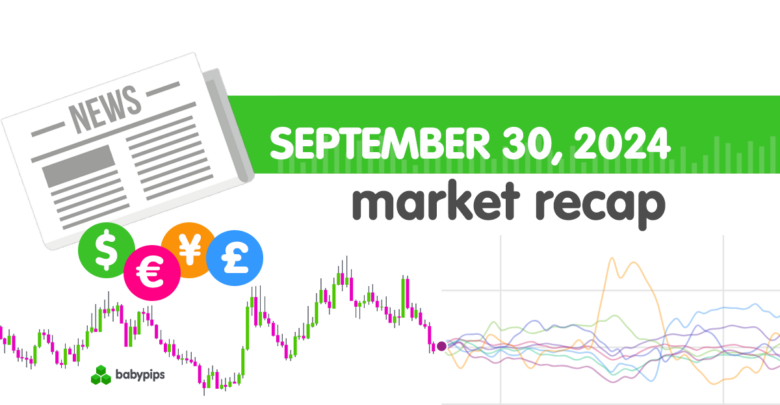Monday was a mixed bag for most asset classes, before dollar pairs managed to find a clear direction during Fed head Powell’s speech.
Commodities found themselves on shaky ground after China printed downbeat PMI figures, yet global equities were able to keep losses in check.
Here are the other updates you should know about!
Headlines:
- On Sunday, PBOC announced it would extend supportive measures for real estate developers to the end of 2026, and advise banks to lower mortgage rates for existing home loans before October 31
- Geopolitical tensions flare as three Palestinian leaders killed in Israel strike in Beirut
- Japanese preliminary industrial production for August: -3.3% m/m (-0.5% expected, previous reading upgraded from 2.8% to 3.1%
- Japanese retail sales in Aug: +2.8% y/y (2.6% y/y expected, 2.7% y/y previous)
- Japan housing starts for August: -5.1% y/y (-3.3% y/y expected, -0.2% y/y previous)
- New Zealand ANZ business confidence index up from 50.6 to 60.9 in Sept
- Chinese official manufacturing PMI improved from 49.1 to 49.8 in Sept (49.4 forecast); non-manufacturing PMI dipped from 50.3 to 50.1 (50.4 forecast)
- China’s Caixin manufacturing PMI down from 50.4 to 49.3 in Sept (50.5 forecast); non-manufacturing PMI down from 51.6 to 50.3 (51.6 forecast)
- Germany Import Prices change for August 2024: -0.4% m/m (-0.2% m/m forecast; -0.4% m/m previous)
- German preliminary CPI read for September 2024: 1.6% y/y vs. 1.9% y/y previous
- Switzerland KOF Leading Economic Indicator for September: 105.5 (102.5 forecast; 105.0 previous)
- During the European Parliament hearing in Brussels, ECB President Lagarde hinted at a potential October rate cut
- Chicago PMI in Sept: 46.6 (46.1 previous, 46.1 consensus)
- During a speech to the National Association for Business Economics, Fed Chair Powell signaled further cuts ahead but stressed that they were ‘not on any preset course’
- New Zealand NZIER business confidence index up from -44 to -1 in Sept
Broad Market Price Action:

Dollar Index, Gold, S&P 500, Oil, U.S. 10-yr Yield, Bitcoin Overlay Chart by TradingView
Majority of asset classes started the day off on a chill note, with the exception of crude oil which tanked from the get-go then proceeded to climb on geopolitical tensions during the Asian trading session. As it turned out, Israel’s launched strikes in Beirut and began its ground invasion on Lebanon, reviving concerns about oil production in the region.
Bitcoin woke up on the wrong side of the bed and carried on with its downward trajectory for the rest of the day, falling from the $66,000 levels down to the $63,500 area. Gold traders also seemed to be in a sour mood throughout the day, as the precious metal closed nearly 1% lower, likely due to mostly downbeat PMI readings from China.
On the flip side, Treasury yields moved in the green around the start of the London session and drew an additional boost from Fed head Powell, who hinted in his testimony that they are in no rush to cut rates but will do what it takes to keep the economy stable.
Meanwhile, U.S. equities initially dipped as investors were disappointed to find out that further rate cuts were not set in stone, but some risk-on flows eventually returned when megacaps like Apple, Microsoft and Alphabet bagged decent gains.
FX Market Behavior: U.S. Dollar vs. Majors:

Overlay of USD vs. Major Currencies Chart by TradingView
Major pairs were off to a mixed start, before the U.S. dollar caught some safe-haven flows when China printed mostly weaker than expected PMI figures. Still, losses for commodity currencies were limited since the Chinese government and central have already doled out massive stimulus packages aimed at boosting the economy.
USD/JPY initially popped higher, following a weaker than expected Japanese industrial production report and some profit-taking after new Japanese PM Shigeru Ishiba’s win last Friday. Still, the yen was able to regain ground thanks to a strong Nikkei performance.
The tide turned around the start of the London session, though, as the U.S. dollar regained ground versus the Aussie, Kiwi, yen and franc while remaining on shaky ground versus the euro and pound. Weaker than expected German preliminary CPI barely dampened the shared currency’s spirits, as traders focused on sticky services inflation.
Another round of mixed price action ensued, before the U.S. dollar drew a strong bid from Powell’s not-so-dovish testimony. After all, he noted that the U.S. economy remains strong but that the Fed just wanted to stay ahead when it comes to minimizing labor market risks, dashing hopes of more aggressive easing moves in the near-term.
Upcoming Potential Catalysts on the Economic Calendar:
- Chinese banks closed for the holiday
- Swiss retail sales at 6:30 am GMT
- Eurozone flash CPI estimates at 9:00 am GMT
- U.S. ISM manufacturing PMI at 2:00 pm GMT
- U.S. JOLTS job openings at 2:00 pm GMT
- New Zealand GDT dairy auction coming up
- FOMC members Barkin, Bostic and Collins to participate in panel discussion at 10:15 pm GMT
We’ve got a handful of top-tier economic releases that could shake things up in the market today!
Among these is the eurozone’s flash headline and core CPI readings for September, which could very well shape ECB policy expectations and influence longer-term EUR trends. After that, look out for the U.S. ISM manufacturing PMI and JOLTS job openings report, both of which are likely to influence NFP positioning and overall market sentiment.
Don’t forget to check out our brand new Forex Correlation Calculator!
